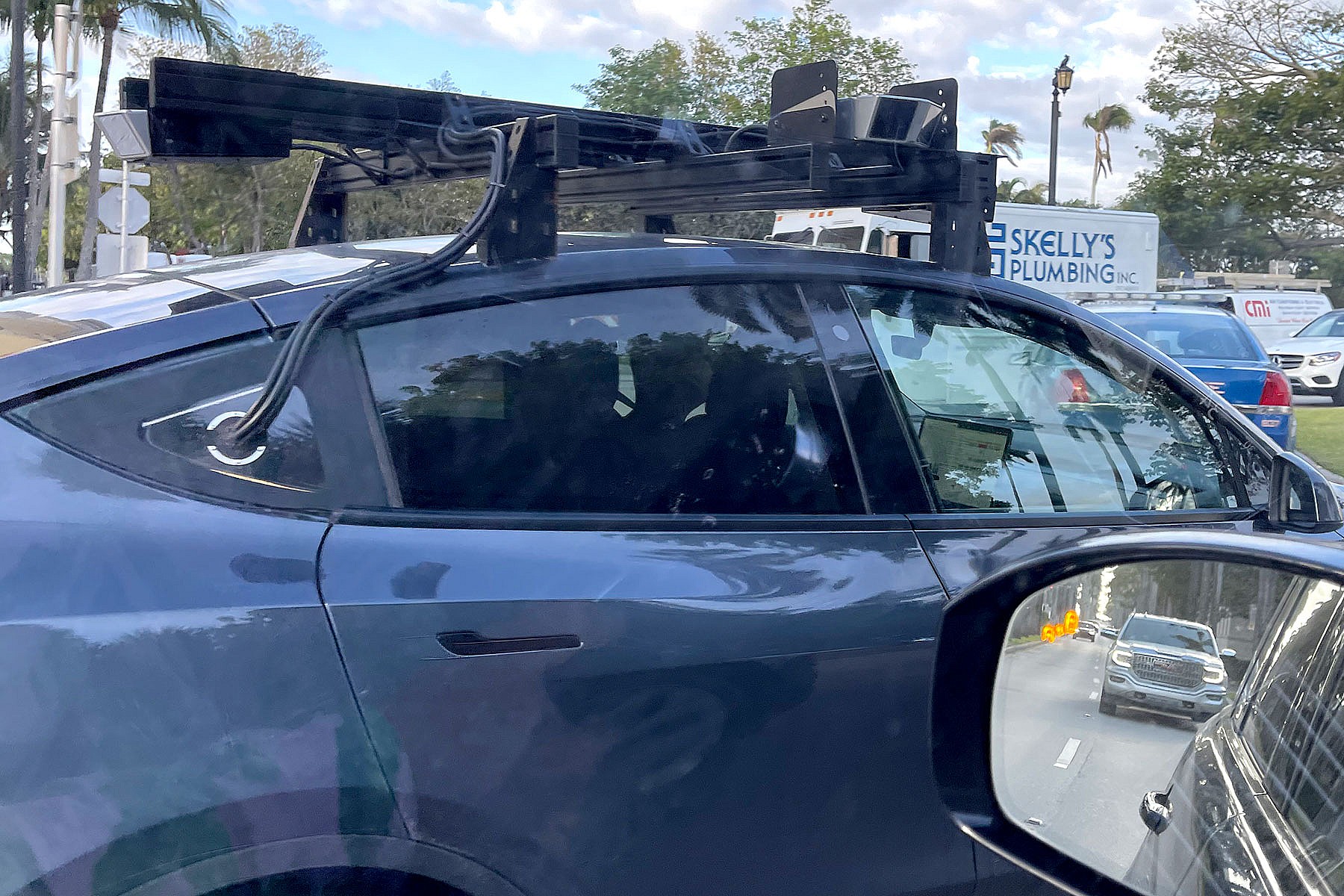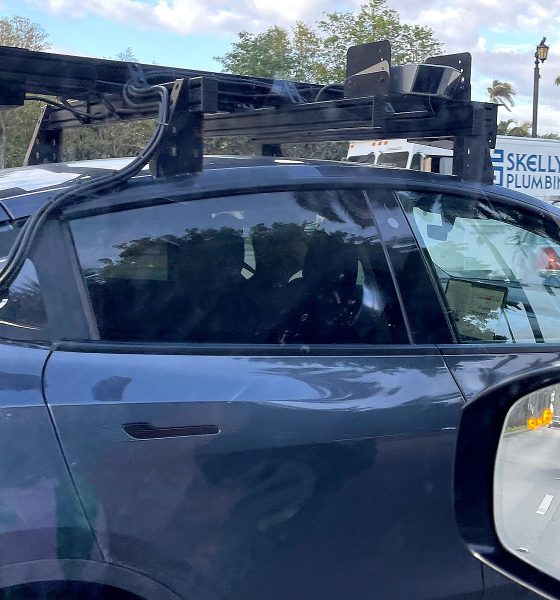

News
Tesla sends Luminar stock upward, but don’t expect Tesla to adopt LiDAR
Tesla’s rumored use of LiDAR systems from Luminar on a Model Y crossover have shot the company’s stock upward. After a Model Y was spotted in Palm Beach, Florida over the weekend sporting a hefty Luminar LiDAR rig, speculation raged on regarding Tesla’s potential use of the system. However, don’t expect Tesla CEO Elon Musk to backtrack on his previous comments on LiDAR, where he called it “a fool’s errand.” The company has other plans for its future self-driving initiatives.
Following the Model Y spotting in Florida on May 20th by Grayson Brulte, there was plenty of speculation regarding Tesla’s potential use of LiDAR systems for its self-driving programs that are still in development. In reality, Tesla has used LiDAR in the past to test its vehicles. The real reasoning behind the testing is not necessarily known, but there are plenty of speculative reasons for the Luminar rig’s installation on top of the Tesla Model Y, and one could be simple benchmarking to test Tesla’s admitted vision-based approach to Full Self-Driving.
Spotted in Palm Beach, Florida. A @Tesla Model Y with #LiDAR and CA Manufacturing (MFG) Plates. Can anyone offer details/insights? pic.twitter.com/5Uh4WU0U41
— Grayson Brulte (@gbrulte) May 20, 2021
To begin, Luminar stock had a healthy boost in value on Monday morning, where it peaked at nearly 9.5% higher than its closing price per share on Friday afternoon. Since the reports this morning, Luminar stock has settled down slightly, trading at only a .37% increase in price. Riding the wave of Tesla’s meteoric influence on stock price, it is probably safe to assume that the news of Tesla utilizing the company’s LiDAR equipment is the reason for the stock surge, but it isn’t expected to stay up there on Tesla’s support alone. Tesla won’t use LiDAR.
Tesla Model X spotted equipped with LiDAR sensors in the wild
Recently, Tesla scrapped its radar and camera-based approach to self-driving in favor of a camera-only system. CEO Elon Musk elaborated on Tesla’s decision to go with a camera-only approach during the Q1 2020 Earnings Call, where he compared the eight exterior cameras on a Tesla to having eight eyes on your head.
“And when your vision works, it works better than the best human because it’s like having eight cameras, it’s like having eyes in the back of your head, beside your head, and has three eyes of different focal distances looking forward. This is — and processing it at a speed that is superhuman. There’s no question in my mind that with a pure vision solution, we can make a car that is dramatically safer than the average person,” Musk said.
Nevertheless, the use of Luminar’s LiDAR systems, in particular, is interesting. Tesla recently lost its Vice President of Legal, Al Prescott, to Luminar. Additionally, Luminar sold the sensors to Tesla as a part of an agreement between the two companies, Bloomberg reported this morning.
Still, despite the use of LiDAR by Tesla as the company continues to refine its self-driving initiatives, there is no indication that Tesla will ever revert its stance on the systems. Earlier today, Tesla removed any reference to radar from its Model 3 and Model Y pages, further solidifying its confidence in camera and vision-based systems for its future rollout of the Full Self-Driving suite.

News
Tesla FSD fleet is nearing 7 billion total miles, including 2.5 billion city miles
As can be seen on Tesla’s official FSD webpage, vehicles equipped with the system have now navigated over 6.99 billion miles.

Tesla’s Full Self-Driving (Supervised) fleet is closing in on almost 7 billion total miles driven, as per data posted by the company on its official FSD webpage.
These figures hint at the massive scale of data fueling Tesla’s rapid FSD improvements, which have been quite notable as of late.
FSD mileage milestones
As can be seen on Tesla’s official FSD webpage, vehicles equipped with the system have now navigated over 6.99 billion miles. Tesla owner and avid FSD tester Whole Mars Catalog also shared a screenshot indicating that from the nearly 7 billion miles traveled by the FSD fleet, more than 2.5 billion miles were driven inside cities.
City miles are particularly valuable for complex urban scenarios like unprotected turns, pedestrian interactions, and traffic lights. This is also the difference-maker for FSD, as only complex solutions, such as Waymo’s self-driving taxis, operate similarly on inner-city streets. And even then, incidents such as the San Francisco blackouts have proven challenging for sensor-rich vehicles like Waymos.
Tesla’s data edge
Tesla has a number of advantages in the autonomous vehicle sector, one of which is the size of its fleet and the number of vehicles training FSD on real-world roads. Tesla’s nearly 7 billion FSD miles then allow the company to roll out updates that make its vehicles behave like they are being driven by experienced drivers, even if they are operating on their own.
So notable are Tesla’s improvements to FSD that NVIDIA Director of Robotics Jim Fan, after experiencing FSD v14, noted that the system is the first AI that passes what he described as a “Physical Turing Test.”
“Despite knowing exactly how robot learning works, I still find it magical watching the steering wheel turn by itself. First it feels surreal, next it becomes routine. Then, like the smartphone, taking it away actively hurts. This is how humanity gets rewired and glued to god-like technologies,” Fan wrote in a post on X.
News
Tesla starts showing how FSD will change lives in Europe
Local officials tested the system on narrow country roads and were impressed by FSD’s smooth, human-like driving, with some calling the service a game-changer for everyday life in areas that are far from urban centers.

Tesla has launched Europe’s first public shuttle service using Full Self-Driving (Supervised) in the rural Eifelkreis Bitburg-Prüm region of Germany, demonstrating how the technology can restore independence and mobility for people who struggle with limited transport options.
Local officials tested the system on narrow country roads and were impressed by FSD’s smooth, human-like driving, with some calling the service a game-changer for everyday life in areas that are far from urban centers.
Officials see real impact on rural residents
Arzfeld Mayor Johannes Kuhl and District Administrator Andreas Kruppert personally tested the Tesla shuttle service. This allowed them to see just how well FSD navigated winding lanes and rural roads confidently. Kruppert said, “Autonomous driving sounds like science fiction to many, but we simply see here that it works totally well in rural regions too.” Kuhl, for his part, also noted that FSD “feels like a very experienced driver.”
The pilot complements the area’s “Citizen Bus” program, which provides on-demand rides for elderly residents who can no longer drive themselves. Tesla Europe shared a video of a demonstration of the service, highlighting how FSD gives people their freedom back, even in places where public transport is not as prevalent.
What the Ministry for Economic Affairs and Transport says
Rhineland-Palatinate’s Minister Daniela Schmitt supported the project, praising the collaboration that made this “first of its kind in Europe” possible. As per the ministry, the rural rollout for the service shows FSD’s potential beyond major cities, and it delivers tangible benefits like grocery runs, doctor visits, and social connections for isolated residents.
“Reliable and flexible mobility is especially vital in rural areas. With the launch of a shuttle service using self-driving vehicles (FSD supervised) by Tesla in the Eifelkreis Bitburg-Prüm, an innovative pilot project is now getting underway that complements local community bus services. It is the first project of its kind in Europe.
“The result is a real gain for rural mobility: greater accessibility, more flexibility and tangible benefits for everyday life. A strong signal for innovation, cooperation and future-oriented mobility beyond urban centers,” the ministry wrote in a LinkedIn post.
News
Tesla China quietly posts Robotaxi-related job listing
Tesla China is currently seeking a Low Voltage Electrical Engineer to work on circuit board design for the company’s autonomous vehicles.

Tesla has posted a new job listing in Shanghai explicitly tied to its Robotaxi program, fueling speculation that the company is preparing to launch its dedicated autonomous ride-hailing service in China.
As noted in the listing, Tesla China is currently seeking a Low Voltage Electrical Engineer to work on circuit board design for the company’s autonomous vehicles.
Robotaxi-specific role
The listing, which was shared on social media platform X by industry watcher @tslaming, suggested that Tesla China is looking to fill the role urgently. The job listing itself specifically mentions that the person hired for the role will be working on the Low Voltage Hardware team, which would design the circuit boards that would serve as the nervous system of the Robotaxi.
Key tasks for the role, as indicated in the job listing, include collaboration with PCB layout, firmware, mechanical, program management, and validation teams, among other responsibilities. The role is based in Shanghai.
China Robotaxi launch
China represents a massive potential market for robotaxis, with its dense urban centers and supportive policies in select cities. Tesla has limited permission to roll out FSD in the country, though despite this, its vehicles have been hailed as among the best in the market when it comes to autonomous features. So far, at least, it appears that China supports Tesla’s FSD and Robotaxi rollout.
This was hinted at in November, when Tesla brought the Cybercab to the 8th China International Import Expo (CIIE) in Shanghai, marking the first time that the autonomous two-seater was brought to the Asia-Pacific region. The vehicle, despite not having a release date in China, received a significant amount of interest among the event’s attendees.








